For the 2025 school year, there are 2 public middle schools serving 648 students in Bessemer City School District. This district's average middle testing ranking is 1/10, which is in the bottom 50% of public middle schools in Alabama.
Public Middle Schools in Bessemer City School District have an average math proficiency score of 3% (versus the Alabama public middle school average of 21%), and reading proficiency score of 23% (versus the 46% statewide average).
Minority enrollment is 99% of the student body (majority Black), which is more than the Alabama public middle school average of 45% (majority Black).
Overview
This School District
This State (AL)
# Schools
8 Schools
534 Schools
# Students
3,121 Students
236,737 Students
# Teachers
151 Teachers
12,843 Teachers
Student : Teacher Ratio
21:1
21:1
District Rank
Bessemer City School District, which is ranked within the bottom 50% of all 145 school districts in Alabama (based off of combined math and reading proficiency testing data) for the 2021-2022 school year.
The school district's graduation rate of 65% has decreased from 73% over five school years.
Overall District Rank
#138 out of 145 school districts
(Bottom 50%)
(Bottom 50%)
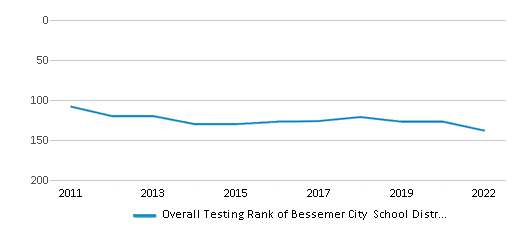
Math Test Scores (% Proficient)
5%
29%
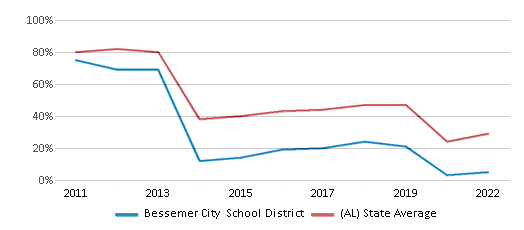
Reading/Language Arts Test Scores (% Proficient)
20%
47%
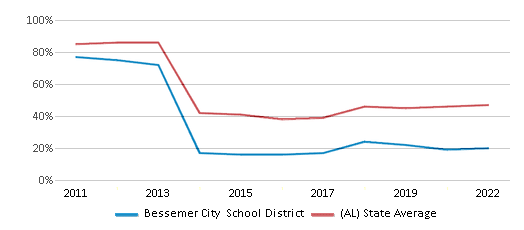
Science Test Scores (% Proficient)
12%
38%
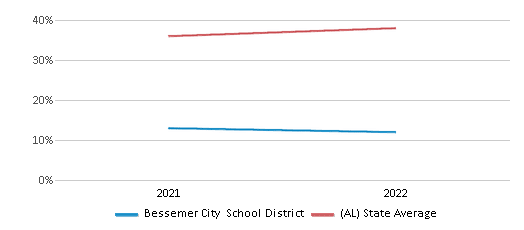
Graduation Rate
65%
88%

Students by Ethnicity:
Diversity Score
0.39
0.61
# American Indian Students
4 Students
3,329 Students
% American Indian Students
n/a
2%
# Asian Students
1 Student
2,720 Students
% Asian Students
n/a
1%
# Hispanic Students
634 Students
24,370 Students
% Hispanic Students
20%
10%
# Black Students
2,356 Students
68,686 Students
% Black Students
76%
29%
# White Students
55 Students
129,762 Students
% White Students
2%
55%
# Hawaiian Students
n/a
257 Students
% Hawaiian Students
n/a
n/a
# Two or more races Students
71 Students
7,613 Students
% of Two or more races Students
2%
3%
Students by Grade:
# Students in PK Grade:
119
2,540
# Students in K Grade:
244
5,092
# Students in 1st Grade:
260
5,246
# Students in 2nd Grade:
273
5,239
# Students in 3rd Grade:
254
5,011
# Students in 4th Grade:
256
5,480
# Students in 5th Grade:
262
10,423
# Students in 6th Grade:
250
39,140
# Students in 7th Grade:
214
55,757
# Students in 8th Grade:
184
56,367
# Students in 9th Grade:
231
13,737
# Students in 10th Grade:
202
11,591
# Students in 11th Grade:
179
10,975
# Students in 12th Grade:
193
10,139
# Ungraded Students:
-
-
District Revenue and Spending
The revenue/student of $15,448 is higher than the state median of $13,006. The school district revenue/student has grown by 25% over four school years.
The school district's spending/student of $14,357 is higher than the state median of $12,220. The school district spending/student has grown by 26% over four school years.
Total Revenue
$48 MM
$9,671 MM
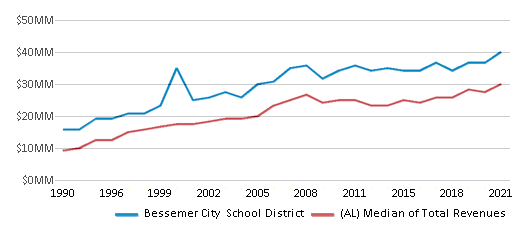
Spending
$45 MM
$9,086 MM
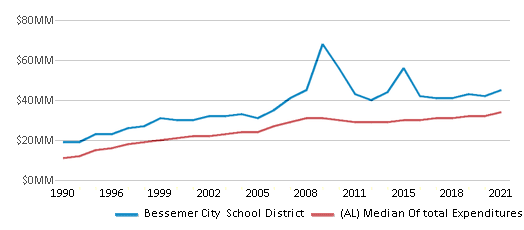
Revenue / Student (19-20)
$15,448
$13,006
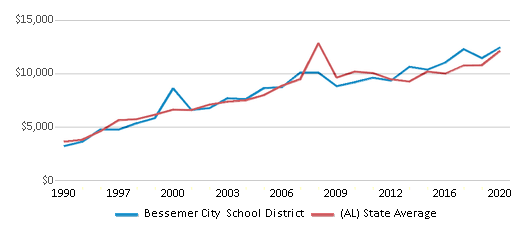
Spending / Student (19-20)
$14,357
$12,220
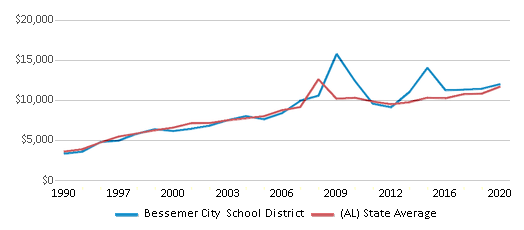
Best Bessemer City School District Public Middle Schools (2025)
School
(Math and Reading Proficiency)
(Math and Reading Proficiency)
Location
Grades
Students
Rank: #11.
Bessemer City Middle School
(Math: 3% | Reading: 23%)
Rank:
Rank:
1/
Bottom 50%10
100 High School Drive
Bessemer, AL 35020
(205) 432-3601
Bessemer, AL 35020
(205) 432-3601
Grades: 6-8
| 648 students
Rank: n/an/a
New Horizon Alternative School
Alternative School
1701 6th Ave N
Bessemer, AL 35020
(205) 432-3036
Bessemer, AL 35020
(205) 432-3036
Grades: 7-12
| n/a students
Recent Articles

What Is A Charter School?
Explore the world of charter schools in this comprehensive guide. Learn about their history, how they operate, and the pros and cons of this educational innovation. Discover key facts about charter schools, including admission policies, demographics, and funding, as well as what to look for when considering a charter school for your child.

10 Reasons Why High School Sports Benefit Students
Discover the 10 compelling reasons why high school sports are beneficial for students. This comprehensive article explores how athletics enhance academic performance, foster personal growth, and develop crucial life skills. From improved fitness and time management to leadership development and community representation, learn why participating in high school sports can be a game-changer for students' overall success and well-being.

February 05, 2025
Understanding the U.S. Department of Education: Structure, Impact, and EvolutionWe explore how the Department of Education shapes American education, from its cabinet-level leadership to its impact on millions of students, written for general audiences seeking clarity on this vital institution.





